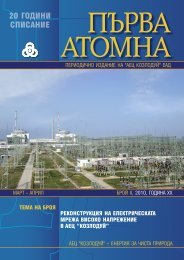Summary Report for Conduct of Kozloduy NPP Stress Tests
Summary Report for Conduct of Kozloduy NPP Stress Tests
Summary Report for Conduct of Kozloduy NPP Stress Tests
Create successful ePaper yourself
Turn your PDF publications into a flip-book with our unique Google optimized e-Paper software.
“<strong>Kozloduy</strong> <strong>NPP</strong>” PLC<br />
SUMMARY REPORT<br />
<strong>for</strong> <strong>Conduct</strong> <strong>of</strong> <strong>Kozloduy</strong> <strong>NPP</strong><br />
<strong>Stress</strong> <strong>Tests</strong><br />
Batteries <strong>of</strong> the safety systems <strong>of</strong> the two units, with the exception <strong>of</strong> the second system <strong>of</strong><br />
unit 5, are assembled with type 106 cells, sequentially connected. The capacity <strong>of</strong> one battery is<br />
1133A/h <strong>for</strong> 10-hour value. The service life is 240 months 196.<br />
The battery <strong>of</strong> the second system <strong>of</strong> Unit 5 is equipped with 106 battery elements, type Vb-<br />
2412, sequentially connected and mounted on seismic metal racks. Battery capacity is 1200/h at 10<br />
hour discharge to 1,8V <strong>of</strong> element at 20°C. The service life is 240 months [23].<br />
All safety system batteries <strong>of</strong> both units are mounted on seismically qualified metal racks.<br />
When per<strong>for</strong>ming real tests on the battery <strong>of</strong> the second train <strong>of</strong> the safety system <strong>for</strong> unit 5<br />
all possible loads are actuated in station blackout mode, the battery supplies power to these loads <strong>for</strong><br />
10 hours and 18 minutes, until voltage reaches 191V. The battery should automatically trip at 180 V<br />
and at continuous extrapolation it is estimated that the battery can last up to 11 hours and 32<br />
minutes.<br />
The actual system load is approximately 250 A with which the battery can be discharged.<br />
For power supply <strong>of</strong> the equipment required <strong>for</strong> startup <strong>of</strong> emergency diesel generators<br />
nickel-cadmium rechargeable batteries with a nominal capacity <strong>of</strong> 270A\h in 10-hour discharge are<br />
used.<br />
1.3.2.6.2 Loads supplied from the batteries<br />
There are two types <strong>of</strong> loads – loads powered with DC power and those powered with AC<br />
power. In normal operation the batteries are in recharging mode and the battery itself and the loads<br />
are powered from 2 nd or 3 rd category in rectifier.<br />
The loads DC power supply is through direct current board. From the buses <strong>of</strong> the safety<br />
systems direct current board respective devices <strong>for</strong> relay protections, control and signalling, devices<br />
<strong>for</strong> safety systems automation, automation and signalling <strong>for</strong> fire alarm and fire fighting, emergency<br />
lighting, etc. are powered [24]. From direct current board <strong>of</strong> the respective diesel generator startup<br />
systems, DG control and auxiliary equipment, emergency lighting and fire alarm are powered.<br />
The loads AC power supply is through inventers. The loads powered this way include I&C,<br />
safety related valves, etc.<br />
1.3.2.6.3 Location and distribution <strong>of</strong> the batteries. Protection against external and internal<br />
impacts<br />
The batteries <strong>of</strong> the safety systems are located at the elevation <strong>of</strong> 13,20 in the reactor<br />
building, in the rooms <strong>of</strong> respective system. Geographically they are separated from each other.<br />
one another.<br />
The batteries to the respective DG are located in the respective diesel cell, independently on<br />
These batteries meet all requirements <strong>of</strong> I category equipment, i.e. physical separation,<br />
independence, lack <strong>of</strong> connection between different trains, seismic rein<strong>for</strong>cement, limited access,<br />
44/202

















